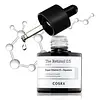What's inside
What's inside
 Key Ingredients
Key Ingredients

 Benefits
Benefits

 Concerns
Concerns

 Ingredients Side-by-side
Ingredients Side-by-side

Water
Skin ConditioningGlycerin
HumectantCoco-Caprylate
EmollientStearic Acid
CleansingCoconut Alkanes
EmollientGlyceryl Stearate
EmollientNiacinamide
SmoothingCaprylic/Capric Triglyceride
MaskingCetearyl Alcohol
EmollientPentylene Glycol
Skin ConditioningPassiflora Edulis Seed Oil
EmollientRetinol
Skin ConditioningSimmondsia Chinensis Seed Oil
EmollientSclerocarya Birrea Seed Oil
HumectantPrunus Armeniaca Kernel Oil
MaskingCetyl Ethylhexanoate
EmollientPalmitoyl Tripeptide-1
Skin ConditioningPalmitoyl Tetrapeptide-7
Skin ConditioningBrassica Oleracea Acephala Leaf Extract
HumectantBrassica Oleracea Italica Extract
AstringentTetrahexyldecyl Ascorbate
AntioxidantChrysin
Skin ConditioningPersea Gratissima Oil
Skin ConditioningLinoleic Acid
CleansingLinolenic Acid
CleansingCeramide NP
Skin ConditioningXanthophylls
Skin ConditioningPhytosphingosine
Skin ConditioningPhytosterols
Skin ConditioningJojoba Esters
EmollientPhysalis Pubescens Fruit Juice
Skin ConditioningStearyl Glycyrrhetinate
Skin ConditioningOryza Sativa Extract
AbsorbentGlycine Soja Oil
EmollientCarthamus Tinctorius Seed Oil
MaskingPalmitoyl Hexapeptide-12
Skin ConditioningCetyl Palmitate
EmollientTrehalose
HumectantLauric Acid
CleansingSodium Hyaluronate Crosspolymer
HumectantOlea Europaea Fruit Oil
MaskingGlucosamine Hcl
Tocopheryl Acetate
AntioxidantCoco-Caprylate/Caprate
EmollientPisum Sativum Extract
Skin ConditioningTocopherol
AntioxidantBambusa Vulgaris Leaf/Stem Extract
HumectantPhenoxyethanol
PreservativeCaprylyl Glycol
EmollientCarbomer
Emulsion StabilisingTrideceth-6 Phosphate
EmulsifyingN-Hydroxysuccinimide
Skin ConditioningCeteareth-20
CleansingSodium Hydroxide
BufferingLaureth-23
CleansingSteareth-20
CleansingPropanediol
SolventChlorhexidine Digluconate
AntimicrobialPolysorbate 20
EmulsifyingTrisodium Ethylenediamine Disuccinate
Chlorphenesin
AntimicrobialPotassium Sorbate
PreservativeEthylhexylglycerin
Skin ConditioningWater, Glycerin, Coco-Caprylate, Stearic Acid, Coconut Alkanes, Glyceryl Stearate, Niacinamide, Caprylic/Capric Triglyceride, Cetearyl Alcohol, Pentylene Glycol, Passiflora Edulis Seed Oil, Retinol, Simmondsia Chinensis Seed Oil, Sclerocarya Birrea Seed Oil, Prunus Armeniaca Kernel Oil, Cetyl Ethylhexanoate, Palmitoyl Tripeptide-1, Palmitoyl Tetrapeptide-7, Brassica Oleracea Acephala Leaf Extract, Brassica Oleracea Italica Extract, Tetrahexyldecyl Ascorbate, Chrysin, Persea Gratissima Oil, Linoleic Acid, Linolenic Acid, Ceramide NP, Xanthophylls, Phytosphingosine, Phytosterols, Jojoba Esters, Physalis Pubescens Fruit Juice, Stearyl Glycyrrhetinate, Oryza Sativa Extract, Glycine Soja Oil, Carthamus Tinctorius Seed Oil, Palmitoyl Hexapeptide-12, Cetyl Palmitate, Trehalose, Lauric Acid, Sodium Hyaluronate Crosspolymer, Olea Europaea Fruit Oil, Glucosamine Hcl, Tocopheryl Acetate, Coco-Caprylate/Caprate, Pisum Sativum Extract, Tocopherol, Bambusa Vulgaris Leaf/Stem Extract, Phenoxyethanol, Caprylyl Glycol, Carbomer, Trideceth-6 Phosphate, N-Hydroxysuccinimide, Ceteareth-20, Sodium Hydroxide, Laureth-23, Steareth-20, Propanediol, Chlorhexidine Digluconate, Polysorbate 20, Trisodium Ethylenediamine Disuccinate, Chlorphenesin, Potassium Sorbate, Ethylhexylglycerin
 Reviews
Reviews

Ingredients Explained
These ingredients are found in both products.
Ingredients higher up in an ingredient list are typically present in a larger amount.
This ingredient is an emollient, solvent, and texture enhancer. It is considered a skin-softener by helping the skin prevent moisture loss.
It helps thicken a product's formula and makes it easier to spread by dissolving clumping compounds.
Caprylic Triglyceride is made by combining glycerin with coconut oil, forming a clear liquid.
While there is an assumption Caprylic Triglyceride can clog pores due to it being derived from coconut oil, there is no research supporting this.
Learn more about Caprylic/Capric TriglycerideGlycine Soja Oil comes from the soybean. Glycine Soja is native to eastern Asia.
Soybean oil is an emollient. It is rich in antioxidants and fatty acids including palmitic, stearic, oleic, and linoleic acids.
As an emollient, the fatty acids in soybean oil helps keep your skin soft and hydrated. It does so by creating a film on top that traps moisture in.
Soybean oil is also rich in vitamin E, a potent antioxidant. Vitamin E is also anti-inflammatory and provides a soothing effect.
Studies show soy may help fade hyperpigmentation from UVB. It does so by disrupting the melanin process from UVB induced skin inflammation.
This ingredient may not be malassezia folliculitis, or fungal-acne, safe.
Soybeans are rich in proteins and are part of the legume family. Foods made with soybeans include tofu, soymilk, edamame, miso, and soy sauce.
Learn more about Glycine Soja OilRetinol is a gold-standard ingredient for anti-aging. It is a form of Vitamin A and belongs to the class of retinoids that also includes tretinoin.
Why is retinol famous?
It has the most scientific studies backing up its skin benefits out of all the non-prescription ingredients.
Retinol is proven to:
This is why retinol is effective at removing wrinkles, fading dark spots, treating acne, and reducing the appearance of pores.
Studies show retinol is less effective when exposed to UV. Be sure to look for appropriate packaging to keep your retinol potent (similar to Vitamin C).
Using retinol or any retinoids will increase sun-sensitivity in the first few months. Though studies show retinoids increase your skin's natural SPF with continuous use, it is best to always wear sunscreen and sun-protection.
We recommend speaking with a medical professional about using this ingredient during pregnancy.
Retinol may cause irritation in some people, so be sure to patch test. Experts recommend 'ramping up' retinol use: start using this ingredient once a week and work up to using it daily.
Read about Tretinoin
Learn more about RetinolTocopherol (also known as Vitamin E) is a common antioxidant used to help protect the skin from free-radicals and strengthen the skin barrier. It's also fat soluble - this means our skin is great at absorbing it.
Vitamin E also helps keep your natural skin lipids healthy. Your lipid skin barrier naturally consists of lipids, ceramides, and fatty acids. Vitamin E offers extra protection for your skin’s lipid barrier, keeping your skin healthy and nourished.
Another benefit is a bit of UV protection. Vitamin E helps reduce the damage caused by UVB rays. (It should not replace your sunscreen). Combining it with Vitamin C can decrease sunburned cells and hyperpigmentation after UV exposure.
You might have noticed Vitamin E + C often paired together. This is because it is great at stabilizing Vitamin C. Using the two together helps increase the effectiveness of both ingredients.
There are often claims that Vitamin E can reduce/prevent scarring, but these claims haven't been confirmed by scientific research.
Learn more about Tocopherol